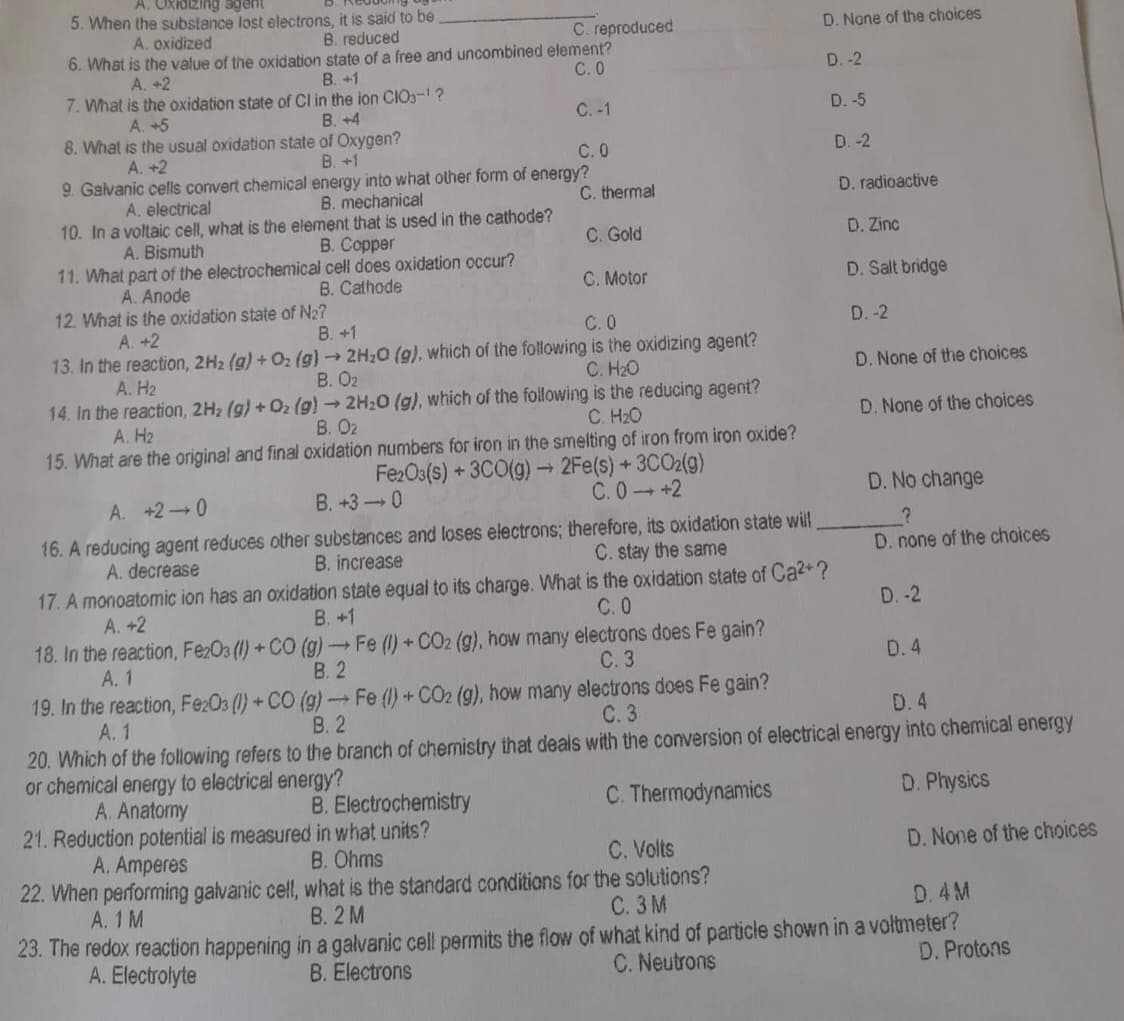A. Uxlotzing agent 5. When the substance lost electrons, it is said to be A. oxidized B. reduced 6. What is the value of the oxidation state of a free and uncombined element? C. 0 A. +2 B. +1 7. What is the oxidation state of Cl in the ion CIO3-¹? C. -1 A. +5 B. +4 2. Wha unual oxidation state of Oxygen? C. reproduced D. None of the choices D.-2 D. -5 D.-2
A. Uxlotzing agent 5. When the substance lost electrons, it is said to be A. oxidized B. reduced 6. What is the value of the oxidation state of a free and uncombined element? C. 0 A. +2 B. +1 7. What is the oxidation state of Cl in the ion CIO3-¹? C. -1 A. +5 B. +4 2. Wha unual oxidation state of Oxygen? C. reproduced D. None of the choices D.-2 D. -5 D.-2
Chapter4: Types Of Chemical Reactions And Solution Stoichiometry
Section: Chapter Questions
Problem 109AE: The blood alcohol (C2H5OH) level can be determined by titrating a sample of blood plasma with an...
Related questions
Question

Transcribed Image Text:A. Oxidizing agent
5. When the substance lost electrons, it is said to be
A. oxidized
B. reduced
D. None of the choices
6. What is the value of the oxidation state of a free and uncombined element?
A. +2
B. +1
C.0
D.-2
7. What is the oxidation state of Cl in the ion CIO3-¹?
A. +5
B. +4
C. -1
D. -5
8. What is the usual oxidation state of Oxygen?
A. +2
B. +1
C. 0
D.-2
9. Galvanic cells convert chemical energy into what other form of energy?
A. electrical
B. mechanical
C. thermal
D. radioactive
10. In a voltaic cell, what is the element that is used in the cathode?
A. Bismuth
B. Copper
C. Gold
D. Zinc
11. What part of the electrochemical cell does oxidation occur?
B. Cathode
A. Anode
D. Salt bridge
C. Motor
12. What is the oxidation state of N₂?
A. +2
B. +1
C.0
D.-2
13. In the reaction, 2H₂ (g) + O₂(g) → 2H₂O (g), which of the following is the oxidizing agent?
C. H₂O
A. H₂
B. 0₂
D. None of the choices
14. In the reaction, 2H₂ (g) + O2(g) → 2H₂O (g), which of the following is the reducing agent?
C. H₂O
D. None of the choices
B. 02
A. H₂
15. What are the original and final oxidation numbers for iron in the smelting of iron from iron oxide?
Fe2O3(s) + 3CO(g) → 2Fe(s) + 3CO2(g)
C.0 +2
B. +3-0
D. No change
A. +2 0
16. A reducing agent reduces other substances and loses electrons; therefore, its oxidation state will
C. stay the same
B. increase
A. decrease
?
D. none of the choices
17. A monoatomic ion has an oxidation state equal to its charge. What is the oxidation state of Ca²+?
B. +1
A. +2
C.0
D.-2
18. In the reaction, Fe2O3 (1) +CO (g) →→Fe (1) + CO2 (g), how many electrons does Fe gain?
A. 1
B. 2
C. 3
D. 4
19. In the reaction, Fe2O3 (1) + CO (g) → Fe (1) + CO2 (g), how many electrons does Fe gain?
A. 1
B. 2
C. 3
D. 4
20. Which of the following refers to the branch of chemistry that deals with the conversion of electrical energy into chemical energy
or chemical energy to electrical energy?
A. Anatomy
B. Electrochemistry
C. Thermodynamics
D. Physics
21. Reduction potential is measured in what units?
A. Amperes
B. Ohms
C. Volts
D. None of the choices
22. When performing galvanic cell, what is the standard conditions for the solutions?
A. 1 M
B. 2 M
C. 3M
D.4M
23. The redox reaction happening in a galvanic cell permits the flow of what kind of particle shown in a voltmeter?
D. Protons
C. Neutrons
A. Electrolyte
B. Electrons
C. reproduced
Expert Solution
This question has been solved!
Explore an expertly crafted, step-by-step solution for a thorough understanding of key concepts.
Step by step
Solved in 2 steps

Knowledge Booster
Learn more about
Need a deep-dive on the concept behind this application? Look no further. Learn more about this topic, chemistry and related others by exploring similar questions and additional content below.Recommended textbooks for you


Chemistry
Chemistry
ISBN:
9781305957404
Author:
Steven S. Zumdahl, Susan A. Zumdahl, Donald J. DeCoste
Publisher:
Cengage Learning

Introductory Chemistry: A Foundation
Chemistry
ISBN:
9781337399425
Author:
Steven S. Zumdahl, Donald J. DeCoste
Publisher:
Cengage Learning


Chemistry
Chemistry
ISBN:
9781305957404
Author:
Steven S. Zumdahl, Susan A. Zumdahl, Donald J. DeCoste
Publisher:
Cengage Learning

Introductory Chemistry: A Foundation
Chemistry
ISBN:
9781337399425
Author:
Steven S. Zumdahl, Donald J. DeCoste
Publisher:
Cengage Learning

Chemistry: An Atoms First Approach
Chemistry
ISBN:
9781305079243
Author:
Steven S. Zumdahl, Susan A. Zumdahl
Publisher:
Cengage Learning

Chemistry by OpenStax (2015-05-04)
Chemistry
ISBN:
9781938168390
Author:
Klaus Theopold, Richard H Langley, Paul Flowers, William R. Robinson, Mark Blaser
Publisher:
OpenStax

Chemistry: The Molecular Science
Chemistry
ISBN:
9781285199047
Author:
John W. Moore, Conrad L. Stanitski
Publisher:
Cengage Learning